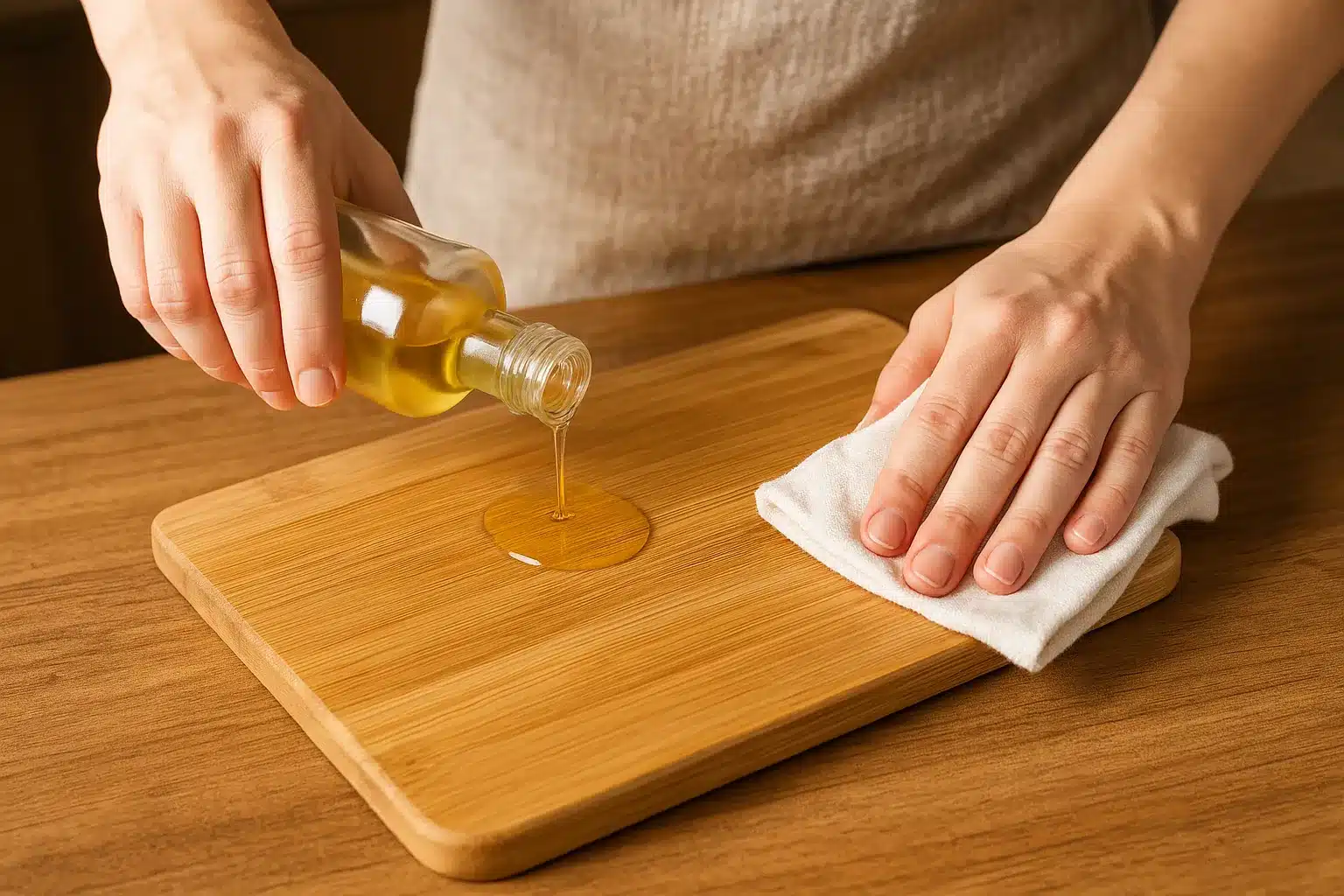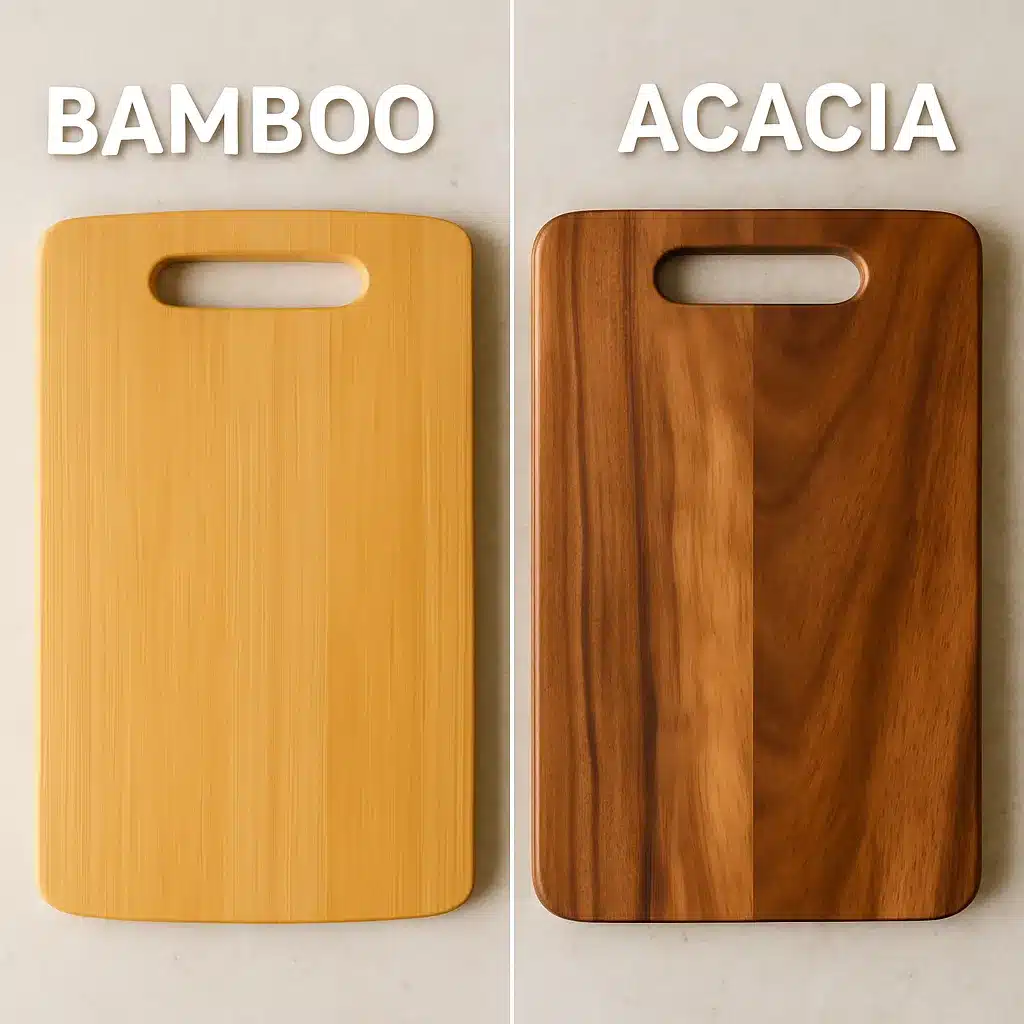You’re not alone if you’re struggling to pick the right cutting board. Bamboo and acacia are two of the most popular choices out there, especially if you’re trying to avoid plastic. But let’s be honest, they don’t perform the same way in real life.
That’s why I put this guide together. I’ll walk you through the real pros and cons of bamboo vs acacia cutting boards. You’ll see how they hold up in everyday use—whether you’re chopping veggies, slicing meat, or serving up snacks.
If you’ve been wondering which one lasts longer, treats your knives better, or just looks good on your counter, I’ve got you covered.
Table of Contents
First, What Are These Boards Made From?
Bamboo and acacia might look similar at first, but they couldn’t be more different.
- Bamboo is actually a type of grass. It grows fast—like, really fast—making it one of the most eco-friendly materials out there. It’s hard, light in color, and looks great in modern kitchens.
- Acacia, on the other hand, is a hardwood. It grows slower than bamboo but is still considered a sustainable choice when harvested the right way. It’s dense, rich in color, and full of character thanks to its unique grain patterns.
So if you’re after something that feels natural and looks good, both have their appeal—you just need to decide what fits your style better. Want to learn more about bamboo’s strengths? Check out my guide on bamboo cutting board pros, cons, and care tips. And if acacia caught your eye, you might find this helpful: How to Season and Maintain a Wooden Cutting Board by Serious Eats, a trusted guide on keeping wooden boards like acacia in top shape.
How Do They Hold Up in Everyday Cooking?
Before we get into the side-by-side comparison, let’s talk about how these boards actually perform when you’re chopping, slicing, or serving food in real life. Because at the end of the day, it’s not just about what sounds good on paper—it’s about what works in your kitchen, right?
Bamboo: Light and Easy to Handle
Bamboo boards are perfect if you need something you can grab and move around easily. They’re great for cutting fruit, bread, veggies, and even meat, as long as you wash them well afterward. They also resist soaking up water and smells, which is handy if you’re cutting garlic one minute and apples the next.
But here’s the thing—bamboo is pretty tough. That means it can wear down your knife edges quicker than softer woods. It also doesn’t love heavy-duty chopping. Push it too hard, and it might crack or split if you don’t keep it oiled.
Acacia: Built to Handle the Heavy Lifting
Acacia boards are solid. They’re heavier, which helps them stay put while you’re chopping. They’re also gentler on your knives, which means fewer trips to the sharpener. Thanks to their natural oils, they handle moisture better and are less likely to warp.
Just keep in mind—they’re a bit more work to care for. You’ll want to oil them a little more often to keep them in top shape.
Quick Comparison
Still not sure which one fits your kitchen best? Here’s a quick side-by-side look at how bamboo and acacia cutting boards compare in real-world use.
| Feature | Bamboo | Acacia |
|---|---|---|
| Durability | Good for light tasks | Great for heavy chopping |
| Knife Friendliness | Hard, can dull knives | Softer, protects knife edges |
| Weight | Light and easy to move | Heavier and more stable |
| Water Resistance | Resists soaking, dries fast | Natural oils help repel moisture |
| Bacterial Resistance | Naturally antimicrobial | Naturally antibacterial |
What About Care and Maintenance?
Both bamboo and acacia need a little love if you want them to last.
- Cleaning: Hand wash only. No dishwashers, no soaking. Just warm water, mild soap, and a towel dry.
- Oiling: Bamboo needs a bit of oil every month or so. Acacia benefits from oiling twice a month if you use it a lot.
- Storage: Keep them standing upright or on their side so they can dry fully between uses.
Care at a Glance:
Both boards are pretty low-maintenance, but they do need a little care if you want them to last. Here’s a quick summary of what you’ll need to do to keep them in good shape.
| Care Step | Bamboo | Acacia |
|---|---|---|
| Cleaning | Hand wash, dry right away | Hand wash, dry right away |
| Oiling | Monthly or when it looks dry | Twice a month for best results |
| Storage | Store upright to air dry | Store upright to air dry |
Neither is completely maintenance-free, but if you keep up with oiling and don’t leave them wet, they’ll both last you for years.

Which One Looks Better in Your Kitchen?
Looks matter too, right? A cutting board isn’t just a tool—it’s something that often sits out on your counter or gets used to serve guests. So, which one brings more style to the table? Let’s take a look.
Bamboo: Clean and Simple
Bamboo boards have a light, smooth look. They fit right in with modern or minimalist kitchen styles. But if you like natural wood grain or darker tones, they might feel a little plain.
Acacia: Warm and Unique
Acacia boards bring the wow factor. Their grain patterns and rich color make them great for serving cheese, bread, or snacks. No two boards look exactly the same, which adds character to your kitchen.
What Should You Expect to Pay?
Bamboo is usually the budget-friendly pick. You can often find good bamboo boards for $20 to $40. Acacia costs a bit more, but it offers better durability and style if you’re willing to spend a little extra.
If you’re comparing prices, you might also want to check out my review of bamboo cutting board sets for budget-friendly options that come in handy sizes for all kinds of prep.
If you’re after something simple and affordable, bamboo’s a solid choice. If you want something that looks great and lasts longer, acacia might be worth the splurge.
Which One’s Right for You?
Here’s the short version:
- Pick Bamboo if you want something light, affordable, and easy to clean. It’s great for quick tasks and looks clean on your counter.
- Pick Acacia if you need something heavier, tougher, and easier on your knives. Plus, it doubles as a great serving board.
Quick Decision Guide:
If you’re still torn between the two, here’s a quick overview to help you decide based on your top priorities.
| You Want… | Go With Bamboo | Go With Acacia |
|---|---|---|
| Lightweight, easy to move | ✅ | |
| Heavy-duty chopping and durability | ✅ | |
| Budget-friendly option | ✅ | |
| Stylish serving board with unique grain | ✅ | |
| Eco-friendly, fast-growing material | ✅ | |
| Gentler surface that protects knives | ✅ |
Frequently Asked Questions About Bamboo and Acacia Cutting Boards
- Bamboo vs Acacia Cutting Boards: Which One Is Better? It really depends on what you need. Bamboo is more eco-friendly and budget-friendly, while acacia is more durable, heavier, and gentler on your knives.
- Can I use bamboo or acacia cutting boards for meat? Yes, both are safe for cutting meat. Just wash them well after handling raw meat to avoid cross-contamination.
- Why do bamboo cutting boards crack? Most cracking happens when bamboo boards aren’t oiled regularly or are left soaking in water. Keeping them dry and oiled helps prevent this.
- Are bamboo or acacia cutting boards more hygienic? Both materials are great at resisting bacteria compared to plastic or soft woods. Bamboo has natural antimicrobial properties, while acacia’s dense grain and oils help keep bacteria away.
- Should you oil an acacia cutting board? Absolutely. Regular oiling helps prevent cracking and keeps the wood from drying out.
- What’s the healthiest material for a cutting board? Bamboo and hardwoods like acacia are both good choices. They’re safer than plastic because they naturally resist bacteria when properly cared for.
- How long will bamboo and acacia cutting boards last? With regular care, bamboo cutting boards can last for several years. Acacia, being heavier and more durable, can last even longer if you keep up with oiling and proper storage.
Bamboo vs Acacia Cutting Boards: Which One Should You Choose?
If you’re looking for something affordable, lightweight, and eco-friendly, bamboo is a great pick. It works well for everyday kitchen tasks and looks clean on the counter.
If you want something that’s built to last, protects your knives, and looks great as a serving board, acacia might be the better choice.
Either way, these bamboo vs acacia cutting boards give you reliable options that make prepping food a little easier—and a lot more enjoyable.

